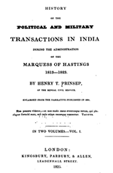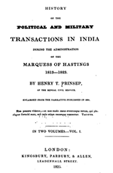Warning: Undefined variable $post in /home/bipinadh/public_html/wp-content/themes/personal/functions.php on line 281
Warning: Attempt to read property "ID" on null in /home/bipinadh/public_html/wp-content/themes/personal/functions.php on line 281
Warning: Array to string conversion in /home/bipinadh/public_html/wp-content/themes/personal/functions.php on line 292
Warning: Undefined variable $pinterest_icon in /home/bipinadh/public_html/wp-content/themes/personal/functions.php on line 430
Henry Thoby Prinsep, History of the Political and Military Transactions in India during the Administration of the Marques of Hastings 1813-1823 (Two Volumes) (London: Kingsbury, Parbury and Allen, 1825)
Many of the writings of Henry Thoby Prinsep (1792–1878), an English official of the Indian Civil Service, are credible. His writings on the origin of Sikh power in Punjáb (1834), the discoveries in Afghanistan (1844), social and political conditions of Tibet, Tartary, and Mongolia (1852) are a few of them.
To Nepalese readers, his book History of the Political and Military Transactions in India during the Administration of the Marques of Hastings 1813-1823 (Two Volumes) (London: Kingsbury, Parbury and Allen, 1825) is of special significance. This is the enlarged edition from the narrative published in quarto in 1820 under the administration of the Marques of Hastings. It gives one of the very early analyses of the Anglo-Nepal War (1814-1816), which ended with a peace treaty that established the sovereignty of East India Company over many territories under the Nepalese control. The book is generally considered by the British side to be a trustworthy narrative of the political and military events of that time in Nepal, Bhopal, Hyderabad, Poona, Nagpoor, Jypoor, Pindarees, and other places of importance in the central India. The preface to the book highlights “its utility as an authentic exposé of the events of the period not having been superseded by any of the publications which had since appeared.”
The author teats the Nepalese part of the history in this book as a special case: “The state of Nipal has purposely been reserved for separate mention, both because its situation and the circumstances which brought it into contact with the British government have no direct connection with the state and powers of central India and because the conduct of their nation, which made war inevitable, even before Lord Hastings had set foot in the country require more specific explanation than suited the cursory view of the condition of other powers taken in the proceeding chapter.”
The book is not set to find “any consistent relation of the means and gradations by which the Goorkhas had risen to power, in the mountainous tract stretching between the plains of Hindoostan and the highlands of Tartary and Tibet. Suffice it to say, that when Lord Hastings took charge of the supreme government [in 1813], he found their dominion to extend as far as the river Teesta to the east and westward to the Sutlej; so that this nation was then in actual possession of the whole of the strong country which skirts the northern frontier of Hindoostan.”
The author, however, describes “[t]he hill rajas, whom [the Goorkhas] had successfully conquered and displaced, were more ignorant, selfish tyrants, on bad terms with their subjects and neighbours, but most of all, with their own relations. Thus, while there was amongst them no principle of combination for mutual defense against a common enemy, not one of the petty principalities was sufficiently strong or united within itself to be capable of substantial resistance.”
Henry Thoby Prinsep also gives his reflection on Prithee Nurayun Sah, the main architect of the Goorkha expansion. He states that Prithee has “the merit of establishing the system which raised this nation to power. Taught by the example of our early victories in Bengal, he armed and disciplined a body of troops after the English fashion; and after a struggle of more than ten years, finally subjugated the valley of Nipal by their means in 1768. The Moorshedabad Nuwab (Kasim Ulee Khan) attempted to interfere in 1762-3, but sustained a single defeat under the walls of Mukwanpoor; and the British government was not more successful in an effort made some years after …”. The later is a reference to Major Kinlock’s expedition undertaken at the recommendation of Mr Golding, the British commercial agent at Betia. He feared that “the success of the Goorkhas would ruin the trade he carried before with Nípal; it had been interrupted for three or four years in consequence of the subjugation of Mukwanpoor.”
The book begins with an analysis of the political economy of the overall military transactions in India. There is an impressive 54-page introduction in which Henry Thoby Prinsep describes relations of the British with native Indian powers, their alliances, subsidiary, and protective. He is very clear as to the natives’ disposition towards British and of states subject to their influence. This helps readers to understand the regional setting of the Anglo-Nepal War of 1814-16. Chapter II deals with the causes of the Nepal War more closely. The first campaign of 1814 is dealt with in Chapter III. Chapter IV builds on the first campaign and elaborates subsequent military strategies of both the countries. The second campaign, the extended war and its intensity, its overall effect, and the process of peace negotiation have been captured by the author in Chapter V. Here the author also describes Hastings’ terms of peace. The Nipalese side in particular refuse cession of Terai. This leads to break-off in negotiation and the initiation of fresh overtures. There is an effort to modify the terms of treaty mediating further concessions. However, Kathmandu refuses the ratification of the peace treaty. Following this development, General Octerlony, the English hero of the war, takes to the field.
Giving an account of Turanee border disputes, Prinsep deals with Sarun frontier and the Gourakhpoor and Bootwal cases. There are references on the proceedings of Sir G. Barlow and Lord Minto, and further aggressions of the Nìipalese. Included is the story of the Indian occupation of 22 villages of Sarun, appointment of a commission by the Governor General, and the resolution of the government on the result of its investigation. Goorkhas counter the occupation of Bootwal by the British. Thus begins the Nepal War and its first campaign. The book also deals effectively with the resolution of Governor General to attack Kumaon in the far west. Prinsep writes about the desperate attacks of Nepal’s hero, Bhugtee Thapa, on Dethoul, his defeat and death. The surrender of another hero, Umur Singh, is another painful event. Notwithstanding the glorious aspects of the Nepalese soldiers, the Anglo-Nepal war was lost to the British.
The author is very clear when he says “the uniform success which had hitherto attended the Goorkhasproduced, in January 1815, an effect on the public mind in the independent portion of India which is more easily imagined than described. Although jealous, naturally, of our preponderance, and suspicious to a degree of any relinquishment of the pacific policy, the native [Indian] powers had so little knowledge of the strength and resources of the Goorkhas, that the war at first excited little sensation.” The preparations of the British side, notes the author, “might have been assimilated to the measures taken in 1812 against the Rewa chief,” a small princely state at central India at that time.
The anticipation and cautiousness with which the British viewed Nepalese soldiers was made very clear. Referring to the Goorkhas, the author says: [t]hey were an experienced as well as a brave enemy: they had been continuously waging war in the mountains for more than fifty years, and knew well how to turn every thing to their best advantage. Caution and judgment were therefore more required against them than boldness of action or of decision; but most of all, that power of intelligence and discrimination which is never without a resource in circumstances the most unexpected.” It is clear from the book, and the account of the war given there, that the Goorkhas were very good warriors, but they were not very critical in the assessment of the enemy on the other side.
The war was a hasty decision. According to Prinsep, the Goorkhas were not clear as to what extent they wanted to go and how. While they decided to “hazard a breech with the British government,” they “never speculated on rousing it to such exertions as they witnessed in the first [military] campaign.” “Notwithstanding their early successes, therefore, they very soon repented of the rash measures by which they had brought themselves into so hopeless a contest. Even when at the height of their prosperity, the immensity of the preparations, and the perseverance of their enemy, convinced them their cause was desperate; and they would willingly have given up every object in dispute, could they by that means have brought the war to an honourable termination. They were prepared also for some sacrifices, if such should be required.”
A letter, which was sent to Kathmandu and intercepted by the British after the fall of Nalapanee, clearly mentioned that the Goorkha commander “was consulted as to the policy of giving up the Dehra Doon and the hilly tract west of the Jumna, in addition to the contested lands on the Saurn and Gourukpoor frontiers.” The person writing the letter was no other than Umur Singh Thapa, a proud commander of the Nepalese side. “That chief’s opinion was adverse to any cession of hill territory.”
The instability in the power spectrum of Nepal was foreseen by the author in very clear terms. Following the ratification of the peace treaty, the King of Nepal died of the small pox. He was a young king who was neither a crucial decision-maker in the war nor in the peace process. When he died on the 20th of November, 1816, he was succeeded by his infant son, Raj Indur Bikrum Sah. The author’s calculation is that “[t]his event contributed to fix more firmly the authority of the party of the General Bheem Sein, by giving him another lease of uncontrolled dominion, pending a second long minority [government].”
Goorkhas. At one point, the author notes, “[i]t is a saying of the Goorkhas that every tree is a mine of gold.” An important caution that must be maintained in reading the book, however, is that this is the perspective of a civil servant of an enemy state explaining how they slashed another fierce, indigenous power that had the tendency to know no bounds at the frontier. The rest is a very informative reading.


